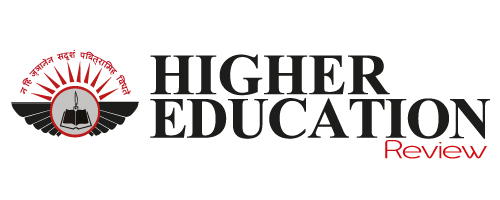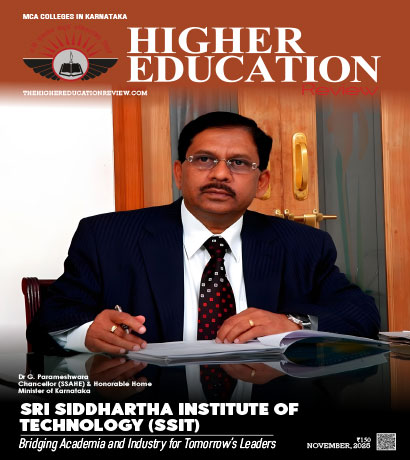Empowering Growth through Continuous Learning
 In an interaction with Higher Education Review, Priyanka Anand, VP & Head HR, Southeast Asia, Oceania, and India, Ericsson, has shared her views and thoughts pertaining to how organizations can cultivate an ongoing learning mindset to stay agile in fast-evolving industries, as well as how technology and innovation contribute to enhancing employee learning and skill growth.
In an interaction with Higher Education Review, Priyanka Anand, VP & Head HR, Southeast Asia, Oceania, and India, Ericsson, has shared her views and thoughts pertaining to how organizations can cultivate an ongoing learning mindset to stay agile in fast-evolving industries, as well as how technology and innovation contribute to enhancing employee learning and skill growth.
Priyanka Anand is an HR leader with over 25 years of global experience in scaling organizations, leadership development, and employee engagement. She focuses on strategic HR, diversity, and fostering innovative, collaborative cultures that empower individuals to thrive.
How can organizations accurately measure the impact and effectiveness of their learning and development programs?
Evaluating the success of learning and development (L&D) initiatives is essential for organizations aiming to foster continuous improvement and maintain competitiveness. While traditional metrics such as training completion rates and participant satisfaction offer a starting point, they don’t provide a full picture. A more comprehensive, multi-layered approach is required—one that connects learning outcomes to both individual growth and broader business goals.
One key element is Business Impact Analysis. This involves gathering structured feedback from employees to understand how learning experiences have influenced their skills, job satisfaction, and performance. More critically, it means quantifying the effect on business outcomes—such as productivity, innovation, and customer satisfaction—offering a more tangible sense of return on investment.
Performance Metrics provide another important lens. Tracking indicators like employee retention, internal mobility, and appraisal outcomes can help organizations understand whether learning programs are translating into real, sustained performance improvements.
Additionally, Behavioural and Cultural Observations offer valuable qualitative insights. Monitoring shifts in how employees interact, collaborate, and embody company values can reveal the deeper influence of learning initiatives on workplace culture. For instance, cultural movements that integrate learning as a lever for mindset change can be measured through regular engagement surveys and workplace observations.
Together, these methods offer a well-rounded evaluation framework—ensuring that L&D efforts are not only improving capabilities but also making a meaningful contribution to business performance and organizational culture.
How can companies ensure that learning and development efforts align with organizational goals and values?
Ensuring alignment between learning and development efforts and organizational goals requires a multi-faceted and intentional approach. The process begins with Comprehensive Need Assessments to identify current skill gaps and areas for improvement. This diagnostic step is essential to ensure that training programs directly support strategic priorities—whether it’s accelerating digital transformation, enhancing customer experience, or fostering innovation.
Equally important is Leadership Engagement. When leaders actively champion and participate in learning initiatives, they set a powerful tone from the top. Their involvement reinforces the message that continuous learning is not optional, but core to how the organization evolves and succeeds.
Embedding Company Values into Learning Contentis another critical component. It ensures that employees not only build functional competencies but also internalize the behaviours and mindsets that reflect the organization's culture and purpose. This creates coherence between what employees learn and how they are expected to lead, collaborate, and make decisions.
Finally, Regular Review and recalibration learning programs is key. The pace of change in today’s business environment demands that L&D strategies stay agile. By continuously assessing the impact of training and adjusting initiatives based on business feedback and workforce needs, companies can ensure their learning agendas remain relevant, high-impact, and aligned with both short- and long-term objectives.
Empowering growth through continuous learning also involves industry exposure. How can partnerships between educational institutions and businesses create more opportunities for real-world learning?
Effective collaboration between academia and industry is increasingly essential to prepare students for the complexities of today’s workforce. These partnerships bridge the gap between academic theory and practical application by aligning curricula with evolving industry needs and creating opportunities for real-world exposure.
One effective model is co-developing specialized programs in emerging technologies such as 5G, AI, IoT, and cloud computing. These programs often blend digital learning modules with in-person expert-led sessions and practical case studies. A successful example is the EricssonEdge Academia Programunder which we have partnered with universities across Asia to upskill students in emerging technologies. This initiative demonstrates how businesses can support the creation of a future-ready workforce. By combining mentorship, technical education, and exposure to real industry challenges, such programs enhance both employability and problem-solving capabilities.
These collaborations are also mutually beneficial. Students gain industry-relevant skills and pathways into graduate roles, while companies build a pipeline of job-ready talent and foster innovation through closer engagement with academia. Guest lectures, internships, and research partnerships further reinforce the connection between learning and career readiness.
Ultimately, such partnerships contribute to a more agile, informed, and innovation-driven talent ecosystem, equipping students to thrive in dynamic, technology-led industries.
Continuous learning is key to real-world success. How can education institutes integrate academic excellence with skill-based education to prepare students for dynamic career landscapes?
To prepare students for the demands of an evolving workforce, education institutes must blend academic rigor with hands-on, skill-based learning. Traditional curricula should be complemented by practical modules that develop critical thinking, digital fluency, and problem-solving abilities, skills essential across industries.
Collaborating with industry partners to co-design courses, introduce project-based learning, and offer access to real-world tools and technologies helps bridge the gap between theory and practice. Initiatives like industry internships, bootcamps, and simulation labs provide exposure to actual business environments, enabling students to apply their knowledge meaningfully.
Equally important is instilling a mindset of lifelong learning. As technologies and job roles evolve, the ability to continuously learn, unlearn, and adapt will be more valuable than any static qualification. Educational institutions must nurture this agility through interdisciplinary learning, mentorship, and access to evolving learning platforms.
By embedding skill development within academic excellence, institutions can equip students not just to enter the workforce - but to lead and innovate within it.
How can organizations cultivate an ongoing learning mindset to stay agile in fast-evolving industries?
Fostering a continuous learning mindset begins with creating a culture that values curiosity, adaptability, and growth. Organizations must embed learning into the everyday workthrough microlearning, peer knowledge sharing, mentorship, on-the-job stretch opportunities etc.
Leadership plays a crucial role. When leaders prioritize their own development and encourage learning within their teams, they set a powerful example. A culture of feedback also helps employees identify their strengths and areas for improvement, promoting continuous growth. Recognizing and rewarding learning behaviours - whether it’s acquiring a new certification, mentoring others, or leading innovation projects, also helps embed learning into performance and culture.
Equipping employees with easy access to diverse learning tools and platforms, including digital content tailored to their roles and career goals, further supports this mindset. In fast-evolving sectors such as telecom, where skills can become outdated quickly, it’s not just about keeping pace - it’s about building resilience and readiness for change.
Ultimately, organizations that embed continuous learning in their organizational culture will be better positioned to adapt, innovate, and thrive.For instance, our "Ericsson on the Move" cultural movement integrates Learning &Development to promote a dynamic company-wide culture of learning, with employee engagement surveys tracking its effectiveness.
How can diversity and inclusion initiatives drive employees’ skill development and accelerate their career growth?
Diversity and inclusion (D&I) initiatives are essential drivers of employee development and organizational growth. A truly inclusive environment values individual differences and ensures equal access to learning and advancement - regardless of gender, background, identity, generation, or experience. This encourages a wider range of perspectives, fosters creativity& innovation, and enhances decision-making.
Targeted programssuch as mentorship, tailored training, and leadership development opportunitieshelp address the unique needs of underrepresented groups. By doing so, organizations can identify skill gaps and design more effective, inclusive learning strategies that promote equity and growth. Employees are motivated to pursue continuous learning and upskilling, knowing that their differences are respected and that there are equal opportunities for advancement. This leads to higher job satisfaction, improved retention, and a more skilled workforce.
How do technology and innovation contribute to enhancing employee learning and skill growth?
Technology and innovation play a crucial role in enhancing employee learning and skill development by offering accessible, flexible, and personalized opportunities. Online courses, webinars, and virtual workshops allow employees to learn at their own pace, overcoming geographical and time constraints. Learning management systems (LMS) and e-learning platforms provide structured pathways for skill development, while AI and ML personalize the learning experience by assessing current skills, identifying gaps, and recommending tailored learning paths. Technologies like AR and VR offer immersive, hands-on training in a safe environment, such as VR simulations for real-world scenarios.
Additionally, technology fosters collaborative learning through tools like video conferencing and social learning platforms, enabling employees to share knowledge and collaborate on projects, regardless of location. Data analytics also plays a vital role in tracking and measuring learning outcomes, helping organizations make informed decisions on future learning initiatives. This data-driven approach ensures that employee development is aligned with organizational goals, fostering continuous growth and improvement. Technology thus not only supports skill development but also enhances collaboration, personalization, and strategic learning, contributing to a more effective and agile workforce.

